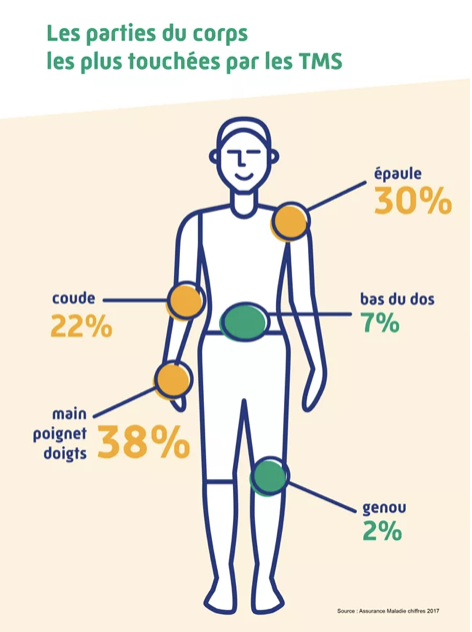MSDs in a nutshell
Musculoskeletal disorders, or MSDs, affect the muscles, joints, tendons and nerves and result in the inability to perform certain movements.
MSDs: most frequently affected parts
The most frequently affected parts of the body are: the upper limbs (elbow, shoulder, wrist) and the back. Several factors, in particular professional, favor these MSDs.
They have multiple causes, but professional activity plays a major role in their appearance or aggravation.
According to Ameli.fr, among the most common MSDs are:
carpal tunnel syndrome in the wrist (38%)
shoulder rotator cuff syndrome (30%)
lateral epicondylitis at the elbow (22%)
lumbago (pain in the lower back) (7%)
MSDs appear when an imbalance is created between the physical capacities of the body and the constraints to which it is exposed. They most often settle gradually, after long periods of intensive stress.
The link between professional activity and MSDs is now well established, which is why MSDs are recognized as occupational diseases.
MSDs: biomechanical factors
The biomechanical factors include movements of force, extreme postures, and repetitive postures:
the posture, outside the comfort zone, can lead to stretching or compression of the structures (standard NF EN 1005-4)
the force, the intensity of the force, the type of muscle contraction, the joint position and the distance of grip, the grip, the characteristics of the object lifted
repetition
the duration of the activity
The combination of these four parameters is more likely to lead to a musculoskeletal disorder.
Source : travail-emploi.gouv.fr
MSDs: environmental factors
Biomechanical constraints can be aggravated by the presence of mechanical pressure, shocks, vibrations, or even the quality of lighting or unfavorable climatic conditions.
MSDs: organizational factors
Organizational and work environment problems such as pace, time constraints, clarity of tasks, insufficient recovery time, schedules, or even interpersonal relations also play a role in the emergence of musculoskeletal problems.
MSDs: psychosocial constraints
These factors are based on how the employee perceives his work:
dissatisfaction with monotonous work
lack of autonomy
the tension generated by the deadlines to be met (time pressure)
the lack of professional recognition and degraded social relations
lack of support from line manager and colleagues
job insecurity
Source : travail-emploi.gouv.fr
MSDs: the three stages
MSDs, unlike a shock, or an injury due to an accident, occur gradually. Three stages can be defined:
Stage 1: the pains appear in action, in particular during the responsible position, and disappear at rest
Stage 2: the pain appears quickly in the activity concerned and takes longer to disappear at rest
Stage 3: the pain is chronic and present both during activity and at rest
MSDs: consequences for the company
MSDs affect a person's health and functioning, at home and at work. The consequences in terms of costs for the company are multiple:
Replacement: overtime for employees present, training and integration of replacements, natural overstaffing to anticipate absenteeism
Management: administrative management of absence and replacement
Social protection: additional pension cover
Organizational: decrease in productivity due to interruptions and the decrease in qualitative and quantitative production
Image: customer dissatisfaction, loss of motivation, and therefore of involvement with increased turnover and difficulty in recruiting
Social: deterioration of the social climate, increased workload for the remaining employees, increased risk of accidents
In conclusion
87% of occupational diseases identified are MSDs
These diseases are underestimated
The total cost of a TMS can vary from €6,800 to €18,220 per employee and per year, not including days off
Investing in prevention and/or treatment is a profitable choice for the company both in financial terms and in terms of image and attractiveness.


